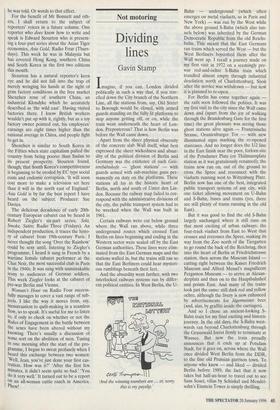Not motoring
Dividing lines
Gavin Stamp
Imagine, if you can, London divided politically in such a way that, if you trav- elled down the City branch of the Northern Line, all the stations from, say, Old Street to Borough would be closed, with armed guards standing on the fully lit platforms to stop anyone getting off, or on, while the train went underneath the heart of Lon- don. Preposterous? That is how Berlin was before the Wall came down.
Apart from the sheer physical obscenity of the concrete slab Wall itself, what best expressed the sheer wickedness and absur- dity of the political division of Berlin and Germany was the existence of such Geis- terebtihnhofe — 'ghost stations' — with guards armed with sub-machine guns per- manently on duty on the platforms. These stations all lay in the historic heart of Berlin, north and south of Unter den Lin- den. Because the railway map failed to cor- respond with the administrative divisions of the city, the public transport system had to be wrecked when the Wall was built in 1961.
Certain railways were cut below ground where the Wall ran above, while three underground routes which crossed East Berlin on lines beginning and ending in the Western sector were sealed off by the East German authorities. These lines were elim- inated from the East German maps and the stations walled in, but the trains still ran so that the East Berliners could hear mysteri- ous rumblings beneath their feet.
And the absurdity went further, with two interlocked railways systems run by differ- ent political entities. In West Berlin, the U- And the winning numbers are ... er, sorry, this is my payslip.' Bahn — underground (which often emerges on metal viaducts, as in Paris and New York) — was run by the West while the above ground S-Bahn (which also tun- nels below) was inherited by the German Democratic Republic from the old Reichs- bahn. This meant that the East Germans ran trains which served the West — but the West Berliners boycotted them after the Wall went up. I recall a journey made on my first visit in 1972 on a seemingly pre- war red-and-ochre S-Bahn train which trundled almost empty through industrial desolation north of Charlottenburg. Soon after the service was withdrawn — but now it is planned to re-open.
For Berlin has come together again the rails soon followed the politics. It was my first visit to the city since the Wall came down and (apart from the joy of walking through the Brandenburg Gate for the first time) the great pleasure was seeing those ghost stations alive again — Franztisische Strasse, Oranienburger Tor — with new illuminated signs marking the re-opened staircases. And no longer does the U2 line in the East finish near the poor, forlorn site of the Potsdamer Platz (or Thalmannplatz station as it was gratuitously renamed); the trains now run on, out of the ground to cross the Spree and reconnect with the viaducts running west to Wittenburg Platz. Berlin now has one of the best, integrated public transport systems of any city, with one ticket allowing movement on U-Bahn and S-Bahn, buses and trams (yes, there are still plenty of trams running in the old East).
But it was good to find the old S-Bahn largely unchanged where it still runs on that most exciting of urban railways: the four-track viaduct from East to West that crosses and recrosses the Spree, snaking its way from the Zoo north of the Tiergarten to go round the back of the Reichstag, then into the heart of Berlin at Friedrichstrasse station, then across the Museum Island cutting right between the Kaiser Friedrich Museum and Alfred Messel's magnificent Pergamon Museum — to arrive at Alexan- derplatz and then on to the Hauptbahnhof and points East. And many of the trains look just the same: still dark red and yellow ochre, although the livery is now enhanced by advertisements for Jiigermeister beer (and, alas, by graffiti inside the carriages).
And so I chose an ancient-looking S- Bahn train for my final exciting and historic journey. In the old days, the S-Bahn west- wards ran beyond Charlottenburg through the Grunewald forest firmly to terminate at Wansee. But now the train proudly announces that it ends up at Potsdam Stadt, for it goes on, across where the Wall once divided West Berlin from the DDR, to the fine old Prussian garrison town. To anyone who knew — and liked — divided Berlin before 1989, the fact that it now takes but half-an-hour to travel out to see Sans Souci, villas by Schinkel and Mendel- sohn's Einstein Tower is simply thrilling.


























































 Previous page
Previous page